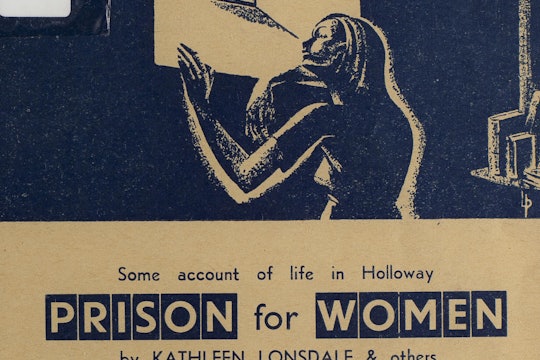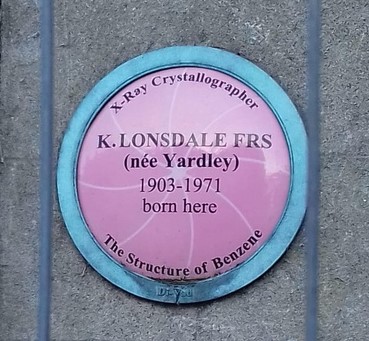
Via Wikimedia
Meet Kathleen Lonsdale, the physicist and prison reformer who cracked benzene's code
Lonsdale assembled her own X-ray crystallography laboratory from scratch to solve a century-old mystery
"I had never heard of Kathleen Lonsdale until today," a professor wrote to me in a recent email. Though I'm a chemist, I hadn't either.
A physicist by training, Kathleen Lonsdale is most famous for revealing the shape of the benzene ring — a molecular scaffold with unusual chemical properties that was considered a mystery to chemists for many years. She was the first to uncover the benzene ring's dimensions and atomic structure. Lonsdale, who was recently commemorated by English Heritage with a London Blue Plaque on the 50th anniversary of her death, also played a fundamental role in establishing X-ray crystallography — technology discovered in the 20th century that allowed scientists to "see" atoms and their spatial arrangement within a molecule. The technique was later critical in the structural studies of a vast number of molecules.
Lonsdale was brilliant, hardworking, and adaptable. Born on January 28, 1903, in Newbridge, Ireland, Lonsdale was the youngest of ten children. Her love for math and physics started during her late school years. She attended the County High School for boys, because the girls’ school didn't teach these subjects. She was so excited to go to university that she declined scholarship funding in her last year of high school to instead start interviews for university. She was accepted at Bedford College for Women at sixteen. She graduated when she was only nineteen, with the highest marks listed in ten years.
Despite this achievement, Lonsdale thought she would have limited job prospects in science. "One of my colleagues applied for 150 posts before he got one, even though he had a good higher degree," she wrote for a book chapter celebrating the 50th anniversary of the discovery of X-ray diffraction. She was surprised when William H. Bragg, Physics Novel Laureate in 1915 and a professor at the University College London, offered her a paid position with his research group to do her master's degree. "It was a luxury and I jumped at it," Lonsdale recalled in the same publication.
Lonsdale continued to earn scholarships and grants, which allowed her to graduate with a masters in physics from the University College London by 1924, and eventually a doctorate in science at the Davy Faraday Laboratory of the Royal Institution by 1929. Lonsdale's doctorate topic on the study of ethane derivatives was included in a famous handwritten book of structure factor formulae, published in 1936. She remained working at the Royal Institution as a researcher until she was appointed as a professor of Chemistry and head of the department of Crystallography in University College London.
Lonsdale's reputation swiftly grew, including among her colleagues in Bragg's research group, like John D. Bernal, a physicist who later worked on X-ray crystallography applied to molecules of life. "Kathleen, despite her unobtrusive ways, had such an underlying strength of character that she became from the outset the presiding genius of the place; her opinions were sought for and her judgment was always respected," he wrote, supporting Lonsdale's nomination to be one of the first two women admitted to the Royal Society.
.jpeg)
Kathleen Lonsdale, elected as president of the British Association for the Advancement of Science
Smithsonian Institute via Wikimedia
While Lonsdale's scientific work could have been interrupted by her marriage and the birth of her three children, she adapted, crediting the support of her husband, Thomas Lonsdale, who was also a researcher in engineering. Because he was a good husband and father, "I could quite well keep on my 'Arbeit' [German word for 'job'], as we called it to distinguish it from the domestic chores. It was great fun," Lonsdale noted. She also received an extra grant to hire a domestic helper. "While he experimented, I did crystallographic calculations," wrote Lonsdale, likely referring to her work on hexamethylbenzene.
She soon revealed the three-dimensional arrangement of the benzene ring, putting an end to a long-standing mystery that chemists had for over sixty years.
Before the 1920s, organic chemists had built substantial knowledge about the chemistry of carbon, mainly through meticulous experiments involving numerous chemical reactions and logical deductions. The progress to determine the spatial distribution of atoms of even one molecule was incredibly slow, requiring the work of large teams of chemists over a dozen years or more.
It wasn't until 1923 that X-ray crystallography began to be used to determine the three-dimensional aspect of organic molecules — molecules composed of carbon atoms, to which other elements, like hydrogen, nitrogen, and oxygen, are attached. The first structure determinations of an organic molecule were that of hexamethylenetetramine in 1923, and of several hydrocarbon chains in 1927. But despite these efforts, the method was impractical. Certain features in a crystal sample could make the diffraction data easier to process through mathematical calculations than others.
Lonsdale quickly saw the need for a tool that could ease the mathematical analysis of crystallographic data, and worked together with her then-labmate, William T. Astbury, to create crystallography tables in 1924. "The usefulness of the Astbury-Yardley Tables, which the Royal Society had to reprint — a very rare event...perhaps lay in the fact that they were intended for immediate practical use," Lonsdale reminisced later.
In 1927, Lonsdale moved to Leeds, where both Lonsdale and her husband had obtained jobs and research positions. While Thomas Lonsdale was completing his doctorate degree, Lonsdale obtained a scholarship from Bedford College so she could carry out research in the physics laboratory at Leeds University. It was there that Christopher K. Ingold, then a professor of Chemistry at Leeds, offered Lonsdale large crystals of hexamethylbenzene, a benzene derivative, which he had prepared.

A series of interpretations of benzene's structure. On the far right is the modern, correct structure
Via Wikimedia
At the time, nobody had been able to prove what the shape of the benzene ring was, and the study of benzene-like derivatives was highly important. While benzene was discovered by Michael Faraday in 1825, more than one hundred years before Lonsdale’s work, a century later, scientists still knew only a few things about benzene and its derivatives: they all shared the same six-carbon ring core, had incredible stability, and baffling reactivity. One of the most memorable and perhaps wild hypotheses on the shape of the benzene ring was made by the chemist August Kekulé from a dream in 1865. In it, he saw atoms dancing in a fizzy image, transforming into an ouroboros — a snake biting its tail. He interpreted this to mean that the carbon atoms had to be bonded like in a ring forming a hexagonal shape.
The simplest aromatic compound was benzene, but it was a liquid, and not suitable for X-ray crystallography. However, because all benzene derivatives contained the same core of six carbon atoms, any benzene derivative could be used to find its dimensions. The derivative hexamethylbenzene, given to Lonsdale, could readily form crystals, so it was perfect for the study.
A little more than 100 years after the discovery of benzene, in 1928, Lonsdale began experimenting on Ingold's sample. She decided to approach the problem anew. "It is better not to have to make an a priori assumption in any structure determination," she wrote in a detailed description. Lonsdale assembled her own X-ray laboratory equipment from scratch, buying and assembling different pieces, and used the apparatus to obtain hexamethylbenzene diffraction patterns.
.jpg)
A pamphlet written by Kathleen Lonsdale called "Prison for Women," an account of her time imprisoned
Via Wikimedia
While the analysis was cumbersome, as more than thirty parameters were required in the calculations, Lonsdale was successful: She demonstrated that the benzene ring could not be anything but a flat hexagon, and provided accurate distances for all carbon-carbon bonds in the molecule. "...[It was] my most fundamental and satisfying piece of research," Lonsdale wrote in a chapter published by the International Union of Crystallography. She published a short summary of her findings in Nature on November 24, 1928.
It was a remarkable achievement at a time where all calculations had to be done by hand. But she didn't stop there. Lonsdale next studied the structure of hexachlorobenzene, another benzene derivative, using an additional mathematical analysis known as the Fourier series. This work was well received by Ingold, who said, "The calculations must have been dreadful, but one paper like this brings more certainty into organic chemistry than generations of activity by us professionals."
When she returned to the Royal Institution in London after her time in Leeds, she found no X-ray instruments available to continue her research. Nevertheless, Lonsdale had already become interested in other research areas that did not require X-rays and tracked down a large electromagnet. Her last work on benzene-like compounds — also known as aromatic compounds — involved the determination of their magnetic properties.

A plaque dedicated to Lonsdale, in Newbridge
Via Wikimedia
Lonsdale was able to use these magnetic parameters to determine the electronic details of aromatic compounds. This established the proof of molecular orbitals — an important concept that allowed the understanding of chemical bonds. However, another prominent scientist, Chemistry Nobel Laurate Linus Pauling, had been working in parallel on the same topic and published his work shortly before Lonsdale.
But Lonsdale also cared about her community. She had strong opinions about scientific knowledge exchange between nations. She became an active advocate for world peace. And when elected a fellow of the Royal Society, she was a vocal advocate for women in science. She had served time in prison for refusing service during World War II, and became an advocate for prison reform, writing an account of her time imprisoned.
There is no doubt Lonsdale significantly contributed to the chemical and physical sciences when little computer power existed. "Kathleen Lonsdale had a profound influence on the development of X-ray crystallography and related fields in chemistry and physics. Very few have made so many important advances in so many different directions," wrote John M. Robertson, a chemist, crystallographer, and Lonsdale's colleague.
Later in life, she continued her work at the Royal Institution, examining synthetic and natural diamonds, kidney stones, developing a technique known as divergent beam X-ray photography, and studying solid-state reactions. Chemistry Nobel laureate Dorothy Hodgkin, who discovered the structure of penicillin and vitamin B12 using X-ray crystallography, said Lonsdale "appeared to own the whole of crystallography in her time."
